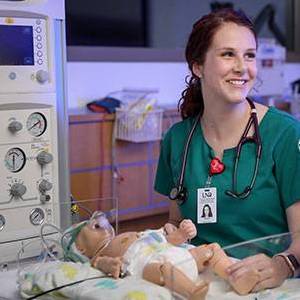Nursing BSN
The on-campus Bachelor of Science in Nursing program (BSN) creates leaders prepared to earn RN licensure and meet the region's growing healthcare needs.
Earning your BSN at UND
How to Apply
You can apply to the on-campus BSN program as an incoming freshman or as a sophomore or junior student. Application to the UND College of Nursing & Professional Disciplines nursing program does not constitute application to the University of North Dakota.
Tuition & Fees
Scholarships
The Department of Nursing is fortunate to have dedicated alumni, friends and donors who support nursing students at UND.
DEPARTMENT OF NURSING SCHOLARSHIP INFORMATION
Nursing Living & Learning Community
LIVE AND LEARN WITH OTHER NURSING STUDENTS
Functional Ability
When considering a Nursing major, undergraduate students should consider that nursing students with or without a reasonable disability-related accommodation must possess the functional ability to perform in several categories listed below in order to be admitted to the program.
- Gross motor skills
- Fine motor skills
- Physical endurance
- Physical strength
- Mobility
- Hearing
- Visual
- Tactile
- Smell
- Reading
- Arithmetic competence
- Emotional stability
- Analytical thinking
- Critical thinking skills
- Interpersonal skills
- Communications skills
It is recognized, however, that degrees of ability vary widely among individuals. Refer to functional ability form sample below for common activities/tasks required in the nursing profession for undergraduate nursing students.
Common Activities/Tasks Required in the Nursing Profession
If you question your ability to perform any of these required common Activities/Tasks, please contact Stephanie Christian, Undergraduate Nursing Chair at 701.777.4505 or stephanie.christian@UND.edu.
| Functional Ability | Activity/Attribute/Task |
|---|---|
| Gross Motor Skills |
|
| Fine Motor Skills |
|
| Physical Endurance |
|
| Physical Strength |
|
| Mobility |
|
| Hearing |
|
| Visual |
|
| Tactile |
|
| Smell |
|
| Reading |
|
| Tell Time |
|
| Emotional Stability |
|
| Analytical Thinking |
|
| Critical Thinking Skill |
|
| Interpersonal Skills |
|
| Communication Skills |
|
Notes: Adapted from: National Council of State Boards of Nursing, Inc. Guidelines for Using Results of Functional Abilities Studies and Other Resources.
December 2012
Individuals with questions can contact UND.undergraduatenursing@UND.edu.
Overview & Outcomes
Graduates earn a Bachelor of Science in Nursing degree and are eligible to sit for the NCLEX-RN® examination administered by the National Council of State Boards of Nursing (NCSBN). The curriculum prepares professional nurses to work in a variety of settings, building upon a foundation of liberal arts, sciences and nursing. Upon completion, BSN graduates will be able to:
- Assume responsibility for leadership and management within health care systems that are influenced by health care policy, economics, and regulatory environments.
- Utilize theoretical and research evidence to inform practice and make clinical judgments in collaboration with other team members.
- Demonstrate competency in integrating innovations in patient care technology while maintaining the patient as the focus of care.
- Communicate and collaborate effectively while working with individuals, families, groups, populations and the health care team to improve health care outcomes.
- Demonstrate values consistent with the practice of professional nursing, including caring, honesty, civility, social justice, and respect for all persons.
- Demonstrate knowledge, skills, and attitudes necessary to provide safe, competent nursing care with diverse populations across the life span.
